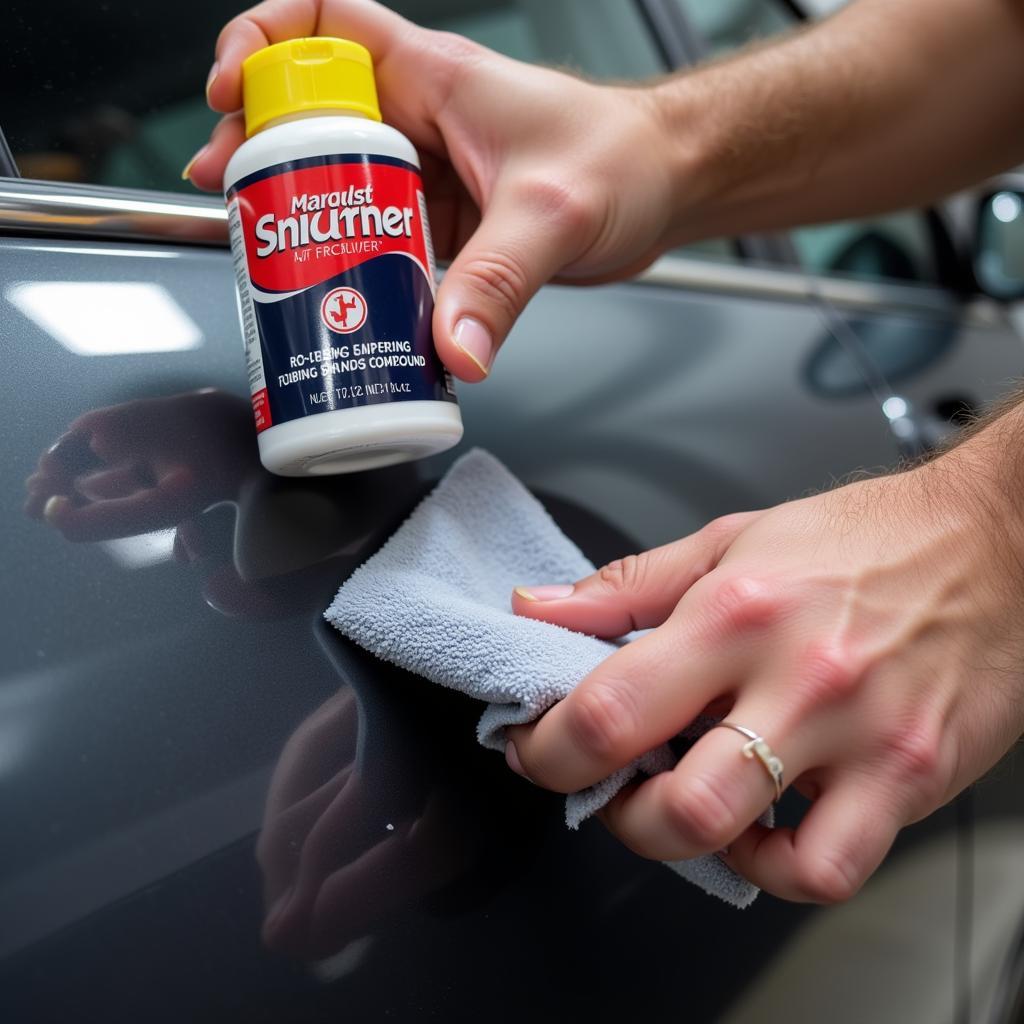Fixing a bad scratch on your car can seem daunting, but with the right approach, it can be tackled effectively. Whether it’s a minor scuff or a deep gouge, understanding the process and having the right tools can save you a trip to the body shop and keep your car looking its best.
After the initial shock of discovering a scratch, assessing the damage is the first step. How deep is it? Does it penetrate the paint and primer, exposing the bare metal? The severity of the scratch will determine the best course of action. For minor surface scratches, a simple DIY approach might suffice. However, deep scratches require more extensive repair. Similar to fixing car windows, addressing scratches promptly prevents further damage.
Assessing the Damage: Is it a Scratch or a Scrape?
Before you start, it’s important to differentiate between a scratch and a scrape. A scratch is typically a thin, linear mark caused by a sharp object, like a key or a branch. A scrape, on the other hand, is usually wider and shallower, often resulting from contact with another object, like a wall or a bumper. This distinction will influence your repair strategy. Deep scratches that expose metal require immediate attention to prevent rust. For less severe scratches, a touch-up paint pen or a polishing compound might be all you need.
DIY Solutions for Minor Scratches
For minor surface scratches that haven’t penetrated the color coat, you can often achieve excellent results with DIY methods. Start by thoroughly cleaning the area with car wash soap and water, ensuring no dirt or debris remains. Then, apply a rubbing compound designed for automotive paint. This will gently abrade the clear coat, leveling the scratch. Follow this with a polishing compound to restore shine and protect the paint. Finally, apply a coat of wax for added protection.
 Applying Rubbing Compound to Car Scratch
Applying Rubbing Compound to Car Scratch
Tackling Deeper Scratches: When DIY Isn’t Enough
Deeper scratches that reach the primer or bare metal require more involved repair methods. This often involves sanding the area to smooth the edges of the scratch, applying primer to protect the metal (if exposed), and then carefully applying touch-up paint to match the car’s color. This process demands patience and precision, and if you’re not comfortable with these steps, seeking professional help is advisable. For situations like this, understanding how to fix paint job on car can be invaluable. Just like with fix rust car door, attention to detail is key.
 Repairing Deep Car Scratch
Repairing Deep Car Scratch
Preventing Future Scratches: Protective Measures
Prevention is always better than cure. Protecting your car’s paint from scratches is much easier than fixing them. Consider using a car cover, especially if you park outdoors regularly. Be mindful of where you park, avoiding areas with low-hanging branches or tight spaces. Regular washing and waxing can also create a protective layer against minor abrasions. Think about it like this, similar to car dealer price fixing, neglecting preventative measures can lead to greater expenses down the line.
“Regular waxing isn’t just about shine,” says automotive expert, Robert Miller, “it’s a crucial protective layer against the elements and minor scratches that can accumulate over time.”
When to Call a Professional
While minor scratches can often be handled at home, deep scratches, especially those involving significant paint damage or bodywork, are best left to the professionals. If you’re unsure about your ability to fix the scratch yourself, or if the damage is extensive, consulting a reputable body shop is recommended. “Assessing the damage accurately is crucial,” adds Sarah Johnson, an experienced auto technician, “Sometimes what looks like a minor scratch can actually be more complex, especially if it involves structural damage.” For those dealing with scrapes on their bumpers, learning about how to fix scrape on car bumper can be beneficial.
 Professional Car Scratch Repair
Professional Car Scratch Repair
Conclusion
Fixing a bad scratch on your car doesn’t have to be a nightmare. By understanding the nature of the damage and choosing the appropriate repair method, you can restore your car’s appearance and protect its value. From DIY solutions for minor scratches to seeking professional help for deeper damage, taking prompt action is essential. For further assistance and expert advice, feel free to connect with AutoTipPro at +1 (641) 206-8880 or visit our office at 500 N St Mary’s St, San Antonio, TX 78205, United States.
FAQ
-
Can I use household cleaners to clean the scratched area? No, household cleaners can damage your car’s paint. Always use car wash soap specifically designed for automotive use.
-
How do I choose the right touch-up paint? Check your car’s owner’s manual or the sticker inside the driver’s side doorjamb for the exact paint code.
-
What if the scratch is on a plastic bumper? The repair process for plastic bumpers is slightly different and may involve using a plastic filler before painting.
-
How can I prevent scratches from happening in the first place? Regular waxing, careful parking, and using a car cover can help protect your car’s paint.
-
Can I fix a deep scratch myself? While possible, it requires patience and skill. If you’re unsure, consult a professional.
-
How much does professional scratch repair cost? The cost varies depending on the severity of the damage and the location of the scratch.
-
What if the scratch has rusted? If the scratch has rusted, it’s essential to remove the rust before attempting any repairs. This may require professional help.





Leave a Reply